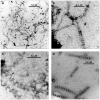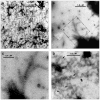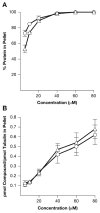(-)-Rhazinilam and the diphenylpyridazinone NSC 613241: Two compounds inducing the formation of morphologically similar tubulin spirals but binding apparently to two distinct sites on tubulin
- PMID: 27311615
- PMCID: PMC4955782
- DOI: 10.1016/j.abb.2016.06.008
(-)-Rhazinilam and the diphenylpyridazinone NSC 613241: Two compounds inducing the formation of morphologically similar tubulin spirals but binding apparently to two distinct sites on tubulin
Abstract
The most potent microtubule assembly inhibitor of newer diphenylpyridazinone derivatives examined was NSC 613241. Because NSC 613241 and (-)-rhazinilam also induce the formation of similar 2-filament spirals, these aberrant reactions were compared. Spiral formation with both compounds was enhanced by GTP and inhibited by GDP and by 15 other inhibitors of microtubule assembly. Similarly, microtubule assembly induced by paclitaxel or laulimalide is enhanced by GTP and inhibited by GDP and assembly inhibitors, but neither [(3)H]NSC 613241 nor [(3)H](-)-rhazinilam bound to microtubules or inhibited the binding of [(3)H]paclitaxel or [(3)H]peloruside A to microtubules. Differences in the pitch of aberrant polymers were found: NSC 613241-induced and (-)-rhazinilam-induced spirals had average repeats of 85 and 79-80 nm, respectively. We found no binding of [(3)H]NSC 613241 or [(3)H](-)-rhazinilam to αβ-tubulin dimer, but both compounds were incorporated into the polymers they induced in substoichiometric reactions, with as little as 0.1-0.2 mol compound/mol of tubulin, and no cross-inhibition by NSC 613241 or (-)-rhazinilam into spirals occurred. Under reaction conditions where neither compound induced spiral formation, both compounds together synergistically induced substantial spiral formation. We conclude that (-)-rhazinilam and NSC 613241 bind to different sites on tubulin that differ from binding sites for other antitubulin agents.
Keywords: (−)-Rhazinilam; 4-morpholineethanesulfonate; DPP; Diphenylpyridazinone derivatives; Glutaraldehyde-fixed microtubules; HPLC; Inhibition of tubulin assembly; MAPs; Mes; NSC 613241; Tubulin polymer of aberrant morphology; diphenylpyridazinone; gMTs; glutaraldehyde-fixed microtubules; high-performance liquid chromatography; microtubule-associated proteins.
Published by Elsevier Inc.
Figures







Similar articles
-
Demonstration of microtubule-like structures formed with (-)-rhazinilam from purified tubulin outside of cells and a simple tubulin-based assay for evaluation of analog activity.Arch Biochem Biophys. 2009 Jul 15;487(2):98-104. doi: 10.1016/j.abb.2009.05.014. Epub 2009 Jun 2. Arch Biochem Biophys. 2009. PMID: 19497297 Free PMC article.
-
Rhazinilam mimics the cellular effects of taxol by different mechanisms of action.Cell Motil Cytoskeleton. 1994;28(4):317-26. doi: 10.1002/cm.970280405. Cell Motil Cytoskeleton. 1994. PMID: 7954858
-
Conformational analysis of rhazinilam and three-dimensional quantitative structure-activity relationships of rhazinilam analogues.Bioorg Med Chem Lett. 2005 Feb 15;15(4):1045-50. doi: 10.1016/j.bmcl.2004.12.027. Bioorg Med Chem Lett. 2005. PMID: 15686909
-
Tubulin rings: which way do they curve?Curr Opin Struct Biol. 2003 Apr;13(2):256-61. doi: 10.1016/s0959-440x(03)00029-0. Curr Opin Struct Biol. 2003. PMID: 12727521 Review.
-
Guanosine-5'-triphosphate hydrolysis and tubulin polymerization. Review article.Mol Cell Biochem. 1982 Sep 3;47(2):97-113. doi: 10.1007/BF00234410. Mol Cell Biochem. 1982. PMID: 6755216 Review.
Cited by
-
Targeting and extending the eukaryotic druggable genome with natural products: cytoskeletal targets of natural products.Nat Prod Rep. 2020 May 1;37(5):634-652. doi: 10.1039/c9np00053d. Epub 2019 Nov 25. Nat Prod Rep. 2020. PMID: 31764930 Free PMC article. Review.
-
Non-Invasive Evaluation of Acute Effects of Tubulin Binding Agents: A Review of Imaging Vascular Disruption in Tumors.Molecules. 2021 Apr 27;26(9):2551. doi: 10.3390/molecules26092551. Molecules. 2021. PMID: 33925707 Free PMC article. Review.
-
Imaging-Guided Evaluation of the Novel Small-Molecule Benzosuberene Tubulin-Binding Agent KGP265 as a Potential Therapeutic Agent for Cancer Treatment.Cancers (Basel). 2021 Sep 24;13(19):4769. doi: 10.3390/cancers13194769. Cancers (Basel). 2021. PMID: 34638255 Free PMC article.
References
-
- Toppmeyer DL, Goodin S. Am J Clin Oncol. 2010;7:516–521. - PubMed
-
- Gradishar WJ. Curr Oncol Rep. 2011;13:11–16. - PubMed
-
- Agarwal N, Sonpavde G, Sartor O. Future Oncol. 2011;7:15–24. - PubMed
-
- Katz J, Janik JE, Younes A. Clin Cancer Res. 2011;17:6428–6436. - PubMed
-
- Krop I, Winer EP. Clin Cancer Res. 2014;20:15–20. - PubMed
MeSH terms
Substances
Grants and funding
LinkOut - more resources
Full Text Sources
Other Literature Sources
Miscellaneous

